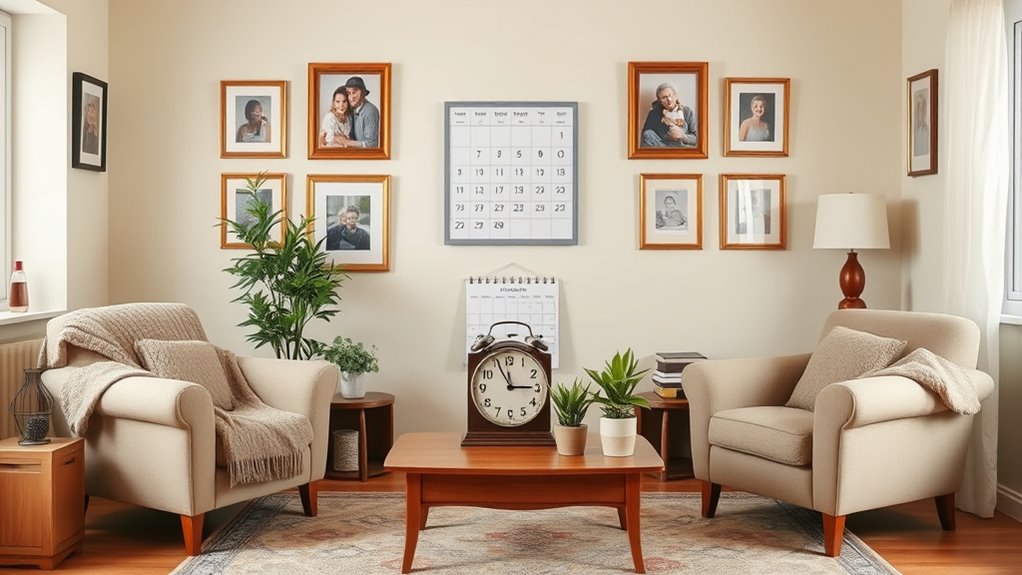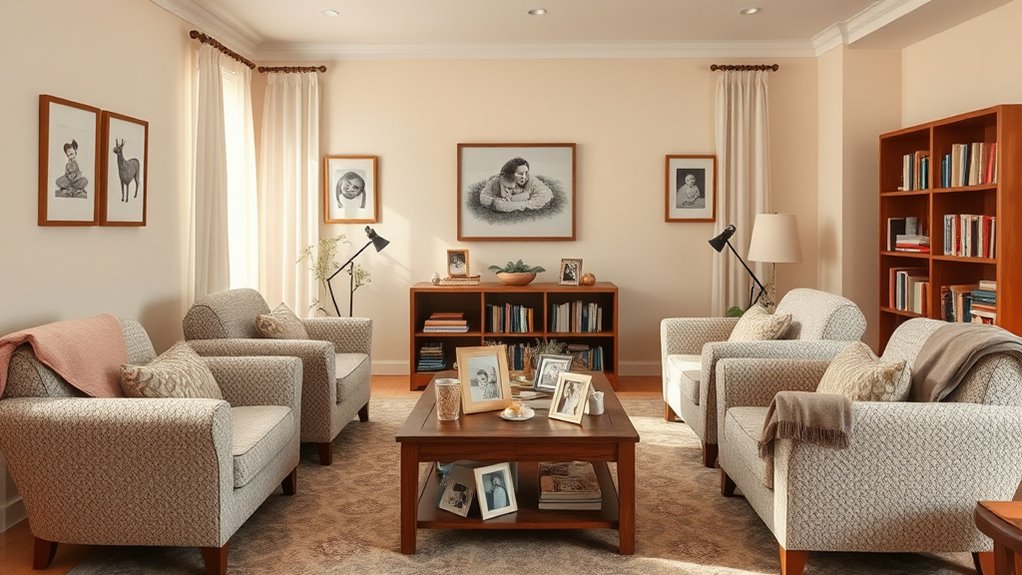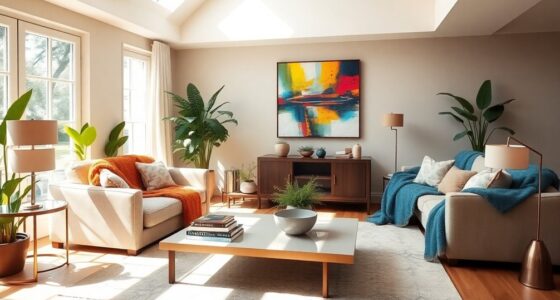To create dementia-friendly, familiar, and soothing spaces, choose soft, warm tones like beige and gentle blues to promote calm. Maximize natural light and use glare-free fixtures to guarantee safety while minimizing shadows. Consistent color schemes, clear contrast, and simple, clutter-free layouts help with orientation and reduce confusion. Gentle lighting transitions at night can ease anxiety, making the environment more secure. Keep exploring ways to make your space more comforting and easier to navigate.
Key Takeaways
- Use muted, warm tones consistently across walls, furniture, and decor to foster familiarity and comfort.
- Incorporate soft, glare-free lighting with natural daylight and warm artificial light to create a calming environment.
- Differentiate spaces and objects with contrasting colors to aid recognition and navigation.
- Maintain a clutter-free, simple design to reduce confusion and promote a sense of security.
- Use familiar, recognizable decor and gentle lighting to support routines and emotional well-being.

Creating a dementia-friendly home is essential for supporting independence and safety. When designing a space that feels familiar and calming, paying attention to color schemes and lighting solutions can make a significant difference. You want to create an environment that reduces confusion and anxiety while promoting easy navigation. Choosing the right color schemes involves selecting muted, warm tones that evoke comfort and familiarity. Avoid loud, contrasting colors that might cause disorientation or overstimulation. Instead, opt for soft beiges, gentle blues, or warm earth tones that create a soothing backdrop. These colors help residents recognize their surroundings without feeling overwhelmed. Consistent use of these tones across furniture, walls, and decor reinforces familiarity and helps distinguish different areas, making it easier for individuals to orient themselves throughout the home. Incorporating cybersecurity measures into smart home devices ensures safety without compromising privacy for vulnerable residents. Lighting solutions are equally important in creating a dementia-friendly environment. Proper lighting minimizes shadows and glare, which can cause confusion or fear. You should prioritize natural light during the day by opening curtains or blinds, as sunlight helps regulate sleep cycles and boosts mood. For artificial lighting, choose fixtures that provide even, glare-free illumination. Use warm-toned bulbs to create a cozy atmosphere, and consider installing motion sensors or nightlights to ensure safe navigation at all hours. Avoid harsh fluorescent lighting, which can be unsettling and cause discomfort. Task lighting in key areas like the kitchen and bathroom offers additional support, making daily activities safer and more manageable. Dimming options or adjustable lighting can also help transition between day and night, reducing agitation and promoting better sleep. Incorporating lighting solutions that are adjustable and gentle can significantly enhance comfort and safety. Additionally, the use of appropriate color contrasts can help individuals differentiate objects and navigate their environment more easily. A well-designed environment also considers environmental consistency, which helps reduce confusion and supports routine. Combining thoughtful color schemes with well-planned lighting solutions creates a space that’s both inviting and functional. The goal is to foster a sense of familiarity and comfort, minimizing stress for the person with dementia. When colors are consistent and lighting is gentle yet effective, it becomes easier for them to recognize familiar objects, navigate safely, and feel more in control of their environment. Remember, simplicity is key—avoid clutter and overly complex designs that can confuse or distract. By focusing on these elements, you help build a home that supports independence, reduces anxiety, and encourages a sense of security. Every detail, from the shades on the walls to the placement of lights, contributes to creating a caring, accessible space where your loved one can thrive.
Frequently Asked Questions
How Can Decor Reduce Anxiety for Dementia Patients?
You can reduce anxiety for dementia patients by incorporating personalized artwork that evokes positive memories and provides a sense of familiarity. Using soothing scents, like lavender or vanilla, also creates a calming environment. Keep decor simple and recognizable, avoiding clutter. These thoughtful touches help patients feel more comfortable and secure, easing their anxiety and promoting a peaceful atmosphere. Small design choices make a big difference in their emotional well-being.
What Colors Are Most Calming in Dementia-Friendly Spaces?
When it comes to calming colors, you want to keep it simple — a picture is worth a thousand words. In color psychology, soft, muted shades like blues, greens, and warm neutrals are most calming in dementia-friendly spaces. These soothing palettes help reduce anxiety and create familiarity. By choosing gentle hues, you’re helping your loved one feel safe and comfortable, making their environment truly feel like a peaceful haven.
How Do You Balance Safety With Aesthetic Appeal?
You balance safety with aesthetic appeal by prioritizing visual harmony, ensuring the space feels calming and inviting. Use decorative accents that are both functional and visually pleasing, like rounded-edged furniture or non-slip rugs in soothing colors. Keep clutter minimal to avoid hazards, but add personal touches that make the environment familiar. This approach creates a safe, attractive space that promotes comfort and independence for those with dementia.
Are There Specific Furniture Styles Recommended for Dementia Care?
Thinking about furniture styles, you’ll want to focus on pieces that feel both comforting and easy to navigate. You might choose antique furniture, which offers familiar shapes and textures, or opt for modern minimalism, which reduces visual clutter and confusion. The goal is to create a space that’s soothing without overwhelming. By balancing these styles, you help foster a sense of familiarity and calm, supporting well-being and independence.
How Often Should Dementia-Friendly Decor Be Updated or Changed?
You should update your dementia-friendly decor as needed based on decor maintenance and seasonal changes. Regularly assess whether the environment still feels familiar and soothing, making adjustments when you notice signs of wear or if seasonal updates are appropriate to maintain comfort. Avoid frequent overhauls; minor, thoughtful updates keep the space calming and familiar, helping your loved one feel secure without confusion or distress.
Conclusion
Creating dementia-friendly decor helps you craft familiar, soothing spaces that support independence and comfort. By incorporating simple, recognizable elements, you make daily life easier for loved ones. Did you know that environments designed with dementia-friendly principles can reduce agitation by up to 50%? That’s a powerful reminder of how thoughtful decor truly makes a difference. So, take small steps today to create a calming, supportive space—your loved ones will feel more at ease and cared for.









